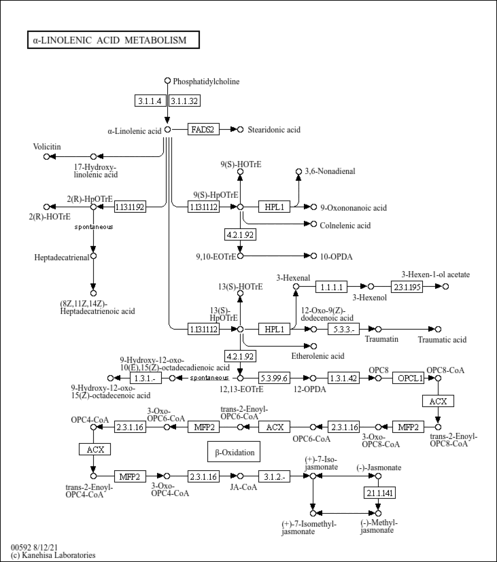| Description | Docosapentaenoic acid (22n-3) (also known as clupanodonic acid) is an essential omega-3 fatty acid (EFA) which is prevalent in fish oils. Docosapentaenoic acid, commonly called DPA, is an intermediary between eicosapentaenoic acid (EPA, 20:5 ω-3) and docosahexaenoic acid (DHA, 22:6 ω-3). Seal oil is a rich source of this metabolite. There are three functions of docosapentaenoic acid. Most importantly, it is a component of phospholipids found in all animal cell membranes, and a deficiency of docosapentaenoic acid leads to faulty membranes being formed. Secondly, it is involved in the transport and oxidation of cholesterol, and clupanodonic acid tends to lower plasma cholesterol. A third function is as a precursor of prostanoids which are only formed from docosapentaenoic acid. Deficiency of this in experimental animals causes lesions mainly attributable to faulty cellular membranes. Outcomes include sudden failure of growth, lesions of the skin, kidney, and connective tissue, erythrocyte fragility, impaired fertility, and the uncoupling of oxidation and phosphorylation. In humans, pure deficiency of docosapentaenoic acid has been studied particularly in persons fed intravenously. A relative deficiency (that is, a low ratio in the body of docosapentaenoic to long-chain saturated fatty acids and isomers of docosapentaenoate) is common in Western diets and plays an important part in the causation of atherosclerosis, coronary thrombosis, multiple sclerosis, the triopathy of diabetes mellitus, hypertension, and certain forms of malignant disease. Various factors affect the dietary requirement of docosapentaenoic acid (PMID: 6469703 ). |
|---|
| Structure | CC\C=C/C\C=C/C\C=C/C\C=C/C\C=C/CCCCCC(O)=O InChI=1S/C22H34O2/c1-2-3-4-5-6-7-8-9-10-11-12-13-14-15-16-17-18-19-20-21-22(23)24/h3-4,6-7,9-10,12-13,15-16H,2,5,8,11,14,17-21H2,1H3,(H,23,24)/b4-3-,7-6-,10-9-,13-12-,16-15- |
|---|
| Synonyms | | Value | Source |
|---|
| (7Z,10Z,13Z,16Z,19Z)-Docosa-7,10,13,16,19-pentaenoic acid | ChEBI | | (all Z)-7,10,13,16,19-Docosapentaenoic acid | ChEBI | | all-cis-7,10,13,16,19-Docosapentaenoic acid | ChEBI | | cis-7,10,13,16,19-Docosapentaenoic acid | ChEBI | | Clupanodonic acid | ChEBI | | Docosa-7Z,10Z,13Z,16Z,19Z-pentaenoic acid | ChEBI | | Docosapentaenoic acid | ChEBI | | DPA | ChEBI | | DPAn-3 | ChEBI | | 7Z,10Z,13Z,16Z,19Z-Docosapentaenoic acid | Kegg | | (7Z,10Z,13Z,16Z,19Z)-Docosa-7,10,13,16,19-pentaenoate | Generator | | (all Z)-7,10,13,16,19-Docosapentaenoate | Generator | | all-cis-7,10,13,16,19-Docosapentaenoate | Generator | | cis-7,10,13,16,19-Docosapentaenoate | Generator | | Clupanodonate | Generator | | Docosa-7Z,10Z,13Z,16Z,19Z-pentaenoate | Generator | | Docosapentaenoate | Generator | | 7Z,10Z,13Z,16Z,19Z-Docosapentaenoate | Generator | | Docosapentaenoate (22N-3) | Generator | | 7,10,13,16,19-Docosapentaenoic acid, (all-Z)-isomer | MeSH | | Docosapentaenoic acid (C22:5 N3) | MeSH | | Osbond acid | MeSH | | (all-Z)-7, 10, 13, 16, 19-Docosapentaenoic acid | MeSH | | 7,10,13,16,19-Docosapentaenoic acid | MeSH | | Docosapentaenoic acid, (all Z)-isomer | MeSH | | (7Z,10Z,13Z,16Z,19Z)-Docosa 7,10,13,16,19-pentaenoate | HMDB | | (7Z,10Z,13Z,16Z,19Z)-Docosa 7,10,13,16,19-pentaenoic acid | HMDB | | 7,10,13,16,19-Docosapentaenoate | HMDB | | FA(22:5(7Z,10Z,13Z,16Z,19Z)) | HMDB | | (7Z,10Z,13Z,16Z,19Z)-7,10,13,16,19-Docosapentaenoic acid | HMDB | | (all-Z)-7,10,13,16,19-Docosapentaenoic acid | HMDB | | FA(22:5n3) | HMDB | | delta7,10,13,16,19-Docosapentaenoic acid | HMDB | | omega3-Docosapentaenoic acid | HMDB | | Δ7,10,13,16,19-Docosapentaenoic acid | HMDB | | ω3-Docosapentaenoic acid | HMDB |
| Show more...
|---|
| InChI Identifier | InChI=1S/C22H34O2/c1-2-3-4-5-6-7-8-9-10-11-12-13-14-15-16-17-18-19-20-21-22(23)24/h3-4,6-7,9-10,12-13,15-16H,2,5,8,11,14,17-21H2,1H3,(H,23,24)/b4-3-,7-6-,10-9-,13-12-,16-15- |
|---|
